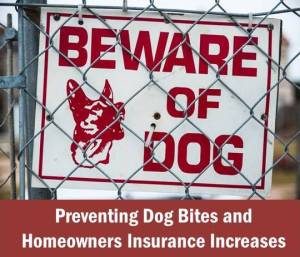 Courtesy of iii.org
Courtesy of iii.org
Almost 90 million dogs are owned as pets in the United States according to a 2017-2018 survey by the American Pet Products Association.
According to the Centers for Disease Control and Prevention, about 4.5 million people are bitten by dogs each year. Among children, the rate of dog-bite–related injuries is highest for those 5 to 9 years old. Over half of dog-bite injuries occur at home with dogs that are familiar to us.
Homeowners and renters insurance policies typically cover dog bite liability legal expenses, up to the liability limits (typically $100,000 to $300,000). If the claim exceeds the limit, the dog owner is responsible for all damages above that amount.
Dog bite liability and homeowners insurance
Some insurance companies will not insure homeowners who own certain breeds of dogs categorized as dangerous, such as pit bulls. Others decide on a case-by-case basis, depending on whether an individual dog, regardless of its breed has been deemed vicious. Some insurers do not ask the breed of a dog owned when writing or renewing homeowners insurance and do not track the breed of dogs involved in dog bite incidents. However, once a dog has bitten someone, it poses an increased risk. In that instance, the insurance company may charge a higher premium, nonrenew the homeowner’s insurance policy or exclude the dog from coverage.
Some insurers are taking steps to limit their exposure to such losses. Some companies require dog owners to sign liability waivers for dog bites, while others charge more for owners of breeds such as pit bulls and Rottweilers and others are not offering insurance to dog owners at all. Some will cover a pet if the owner takes the dog to classes aimed at modifying its behavior or if the dog is restrained with a muzzle, chain or cage.
Homeowners insurance liability claims
- Homeowners insurers paid out over $686 million in liability claims related to dog bites and other dog-related injuries in 2017, according to the Insurance Information Institute (I.I.I.) and State Farm®.
- An analysis of homeowners insurance data by the I.I.I. found that the number of dog bite claims nationwide increased to 18,522 in 2017 compared to 18,123 in 2016—a 2.2 percent increase.
- The average cost per claim for the year increased by 11.5 percent. The average cost paid out for dog bite claims nationwide was $37,051 in 2017, compared with $33,230 in 2016. The average cost per claim nationally has risen more than 90 percent from 2003 to 2017, due to increased medical costs as well as the size of settlements, judgments and jury awards given to plaintiffs, which are trending upwards.
- California continued to have the largest number of claims in the United States, at 2,228 in 2017, an increase from 1,934 in 2016. The state with the second highest number of claims was Florida at 1,345. Florida had the highest average cost per claim at $44,700. The trend in higher costs per claim is attributable not only to dog bites but also to dogs knocking down children, cyclists, the elderly, etc., which can result in injuries that impact the potential severity of the losses.
State and local legislation
Dog owners are liable for injuries their pets cause if the owner knew the dog had a tendency to bite. In some states, statutes make the owners liable whether or not they knew the dog had a tendency to bite; in others, owners can be held responsible only if they knew or should have known their dogs had a propensity to bite. Some states and municipalities have “breed specific” statutes that identify breeds such as pit bulls as dangerous; in others individual dogs can be designated as vicious. At least two states, Pennsylvania and Michigan, have laws that prohibit insurers from canceling or denying coverage to the owners of particular dog breeds. In Ohio, for example, owners of dogs that have been classified as vicious are required to purchase at least $100,000 of liability insurance.
The American Kennel Club reports that while many municipalities have enacted bans on specific breeds, several states have laws barring municipalities and counties from targeting individual breeds.
- Dog owners’ liability: There are three kinds of law that impose liability on owners:
1) A dog-bite statute: where the dog owner is automatically liable for any injury or property damage the dog causes without provocation.
2) The one-bite rule: where the dog owner is responsible for an injury caused by a dog if the owner knew the dog was likely to cause that type of injury—in this case, the victim must prove the owner knew the dog was dangerous.
3) Negligence laws: where the dog owner is liable if the injury occurred because the dog owner was unreasonably careless (negligent) in controlling the dog. - Criminal penalties: On January 26, 2001, two Presa Canario dogs attacked and killed Diane Whipple in the doorway of her San Francisco, California, apartment. Marjorie Knoller, the owner of the dogs, was convicted of involuntary manslaughter for keeping a mischievous dog that killed a person. She was sentenced to four years in prison for involuntary manslaughter and was ordered to pay $6,800 in restitution. Her husband, Robert Noel, was convicted on lesser charges but also received a four-year prison sentence. Knoller became the first Californian convicted of murder for a dog’s actions. This was only the third time such charges have been upheld in the United States, the first coming in Kansas in 1997.



